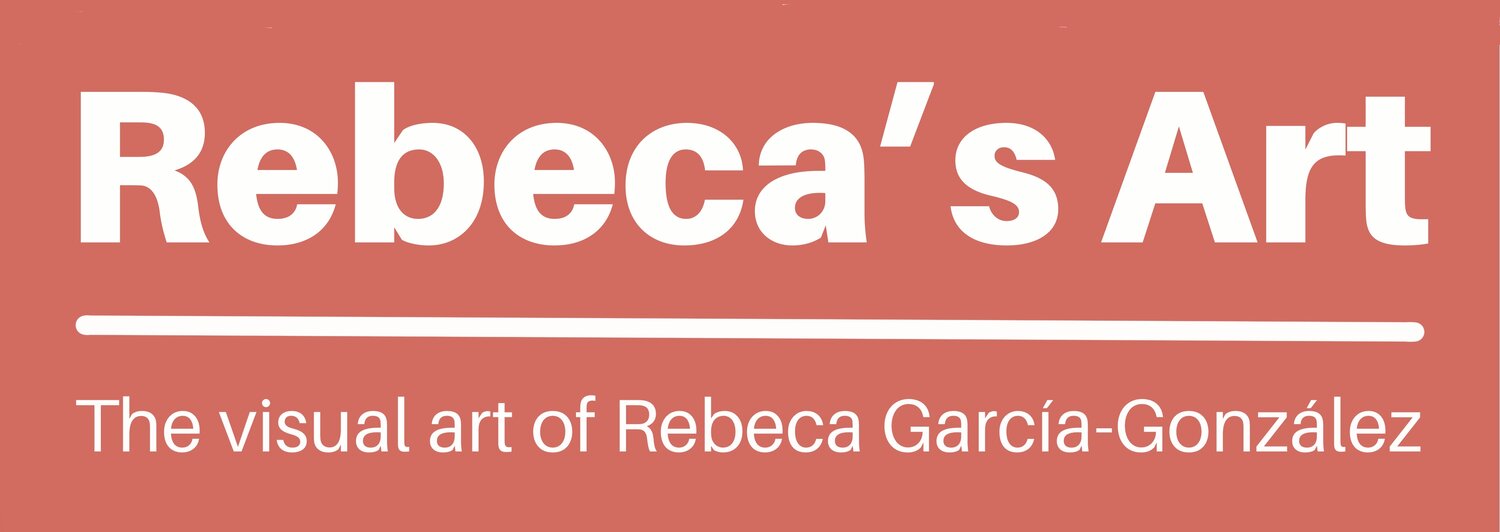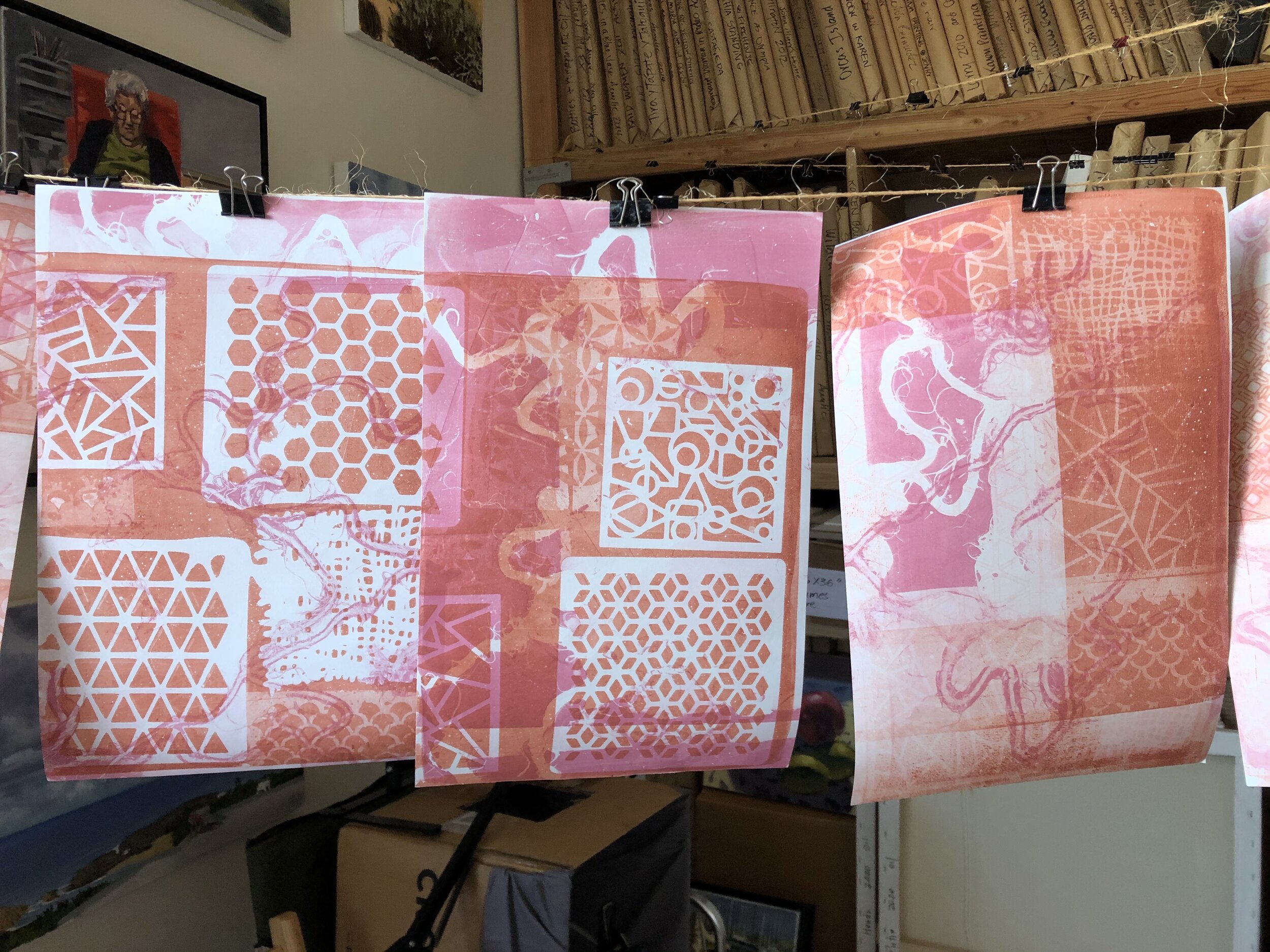The Humble Gel Print
Every winter I take advantage of the rainy weather to retreat to my studio, where I make gel prints for the whole year. Since I like to work large, I melt all of the smaller gel plates I use for workshops and use the glycerin/gelatin mix to cast a 22 x 16 x 4″ plate using my own recipe. The plate needs to be thick enough to withstand being taken out of the mold and placed on a rigid surface. Once there, I am able to use a plate for six months or more. Moisture evaporates, and this makes it more dense and sturdy. Should it get damaged in any way, I can recast it. No mold grows on it because it has a preservative.
The inked gel plate, all ready to go!
I use Akua inks because they have no chalk, and I use extenders and other additives to ensure I can apply a thin coat with a brayer, but you can use the cheaper block printing inks available at any art store.
Over time I have collected all kinds of objects to help me “print” textures on the plate itself. These textures are transferred to paper very easily, since gel plates are ultra sensitive. I use letterpress wooden letters, plastic bags, fabric, rubber bands, leaves, jute, plastic toys, string, bubblewrap, wood blocks, washers, buttons, legos, pill bottle caps, stencils, and rubber stamps. Some of my most prized pieces were rescued from the trash!
Another way to print is to place flat objects between the plate and the paper. Look at the top photo, and you will see what I mean. Most of those images can be considered “negative prints” because the stencil I used lies between the plate and the sheet of paper, producing an outline that has the paper’s color. I am usually able to get at least two prints from each application. That is because each printed sheet will become a positive and a negative image.
Bruce Lee Triptych as an altered book in honor of Kato Jaworski. Marker on gel prints.
I hang the sheets to dry and later bind them into sketchbooks or use them for drawing. This pandemic winter I have been doing both things, so I can have enough printed backgrounds for a series of ink portraits. Normally I do not use a dip pen to draw with ink, but the chalk in these gel prints tends to clog most pens… except for dip pens or markers. During this time of social distancing I have been working from photos that I display on my cell phone. Sometimes, less detail is better. I do not make a pencil sketch first. I like to go straight to ink. It does give me a sense of adventure and I incorporate the planning marks to the drawing.
Sketchbook ink and marker on gel print.
Even though I do work on a large plate and no two prints are the same, these are not monoprints. Not only I am using relief methods to print on the gel plate, very little I do can be considered “painting”. Most of the prints that come out of this process can be considered proofs, and I don’t sign them unless I feel they are of decent quality. What I produce can be considered valiable editions (V.P.). The unsigned ones tend to end up as collages. I usually strive to produce a series of good prints as I print pages for my sketchbooks and drawings, and when I am finished, I sign and sell the best ones.
Collage made with various gel prints.
“I would love to take your workshop,” is what some social media followers have told me. In the last couple of years I have taught a very popular gel printing one-day workshop for the Richmond Art Center. Now with the pandemic, all instruction is via Zoom and this has affected what I can teach. When I taught the workshop face-to-face, I used to pre-cast gel plates on dollar store metal trays so that my students could experience the sensitivity of actual gelatin versus the hard-as-nails, expensive Gelli plates from art stores. This worked well and my students would walk away ready to make their own. Now that we are enforcing social distancing, I am wondering if I could send my students a set of instructions so they can cast their own plates at home prior to the workshop. There is certainly a cottage industry of gel plate making tutorials on Youtube, so I think this is possible.
Another challenge is that successful printing on gel plates does depend on using certain techniques. My students would need to get on Zoom using their phone (instead of their computer) so I could literally “look over their shoulder,” and give them feedback as they go. This is harder, as many of my students are new to Zoom and most have co-opted a kitchen or guest room as their art-making space. I it is very difficult to remotely help people “rig” a cell phone with good lighting so I can actually see what they’re doing.
Linocut print on a gel print.
So the best I can do for now is to wait until the virus abates, and hope I can teach this technique in person someday.







